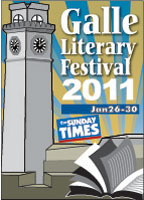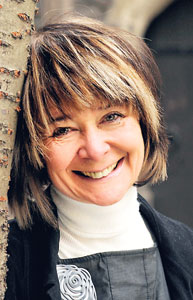“History is largely male and largely the story of those in power,” says Sarah Dunant. Having spent the last few years in hot pursuit of nuns, courtesans and 15th century Florentine women, she should know. Shortlisted for the 2010 Walter Scott Prize, her novel ‘Sacred Hearts’ is the last in an Italian Renaissance Trilogy that began with ‘The Birth of Venus’ and ‘In the Company of the Courtesan’. Her novels bring ancient history to vivid, dramatic life and typically conclude with a bibliography that sprawls over several pages – testament to her determination to accurately recreate the social milieu down to the details.
 |
Unfortunately, her protagonists are hard to find in the history books. Neglected by the male historians of their time, Sarah says it has taken two generations of scholars emerging from a feminist moment to go back into archives and records and dig out, or reconstruct from fragments, female lives and stories, in a way which makes the past a more balanced and multi-dimensional affair. “In this way, little by little, we are righting the balance,” she says, “in a way - thank goodness - you could say we are rewriting history.”
Sarah is also the creator of the now retired private investigator Hannah Wolfe and has won a Crime Writers’ Association Macallan Silver Dagger for Fiction. She is a critic and broadcaster and is a patron of the Orange Prize for Fiction. Her other novels include ‘Transgressions’ (1997) and ‘Mapping the Edge’ (1999), both of which are being adapted as films.
Sarah will be in Sri Lanka to attend GLF 2011, but it won’t be her first visit. Almost 30 years ago, she spent six weeks on the island as “a young hippy with a rucksack on my back.” Travelling to Polonnaruwa, then on to Nuwara Eliya, she remembers walking to World’s End to watch the sunrise, finally ending up in a tiny guest house in Hikkaduwa where “the people, the sun and the sea made me want to stay forever.” Anticipating her visit, she says she’s looking forward to seeing it all - and more - again.
What are you reading now?
I am always reading more than one book at any given time. At the moment by day I am incarcerated in the British Library reading about Renaissance Rome. I want to set my next novel there at the end of the 15th century during the time of the Borgias, and it is a huge challenge to imagine what the city actually looked and felt like. (Cities become characters as much as people I find).
When we think of Rome we tend to think of it as something grand, but then it was small and much of it still medieval or in ruins (the ancient part). The exception was the outrageously rich palaces that were being built by the cardinals and Popes. So, a place of beauty and squalor, wealth and poverty, modern and ancient history all living side by side.
When I get home, my evening reading comes from the leaning tower of Pisa book stack which is precariously perched next to my bed. Right now my favourite is on the top. Non-fiction, it’s called “A Book of Silence” by Sara Maitland.
As the title suggests it’s an investigation into the power and wonder of silence in our lives and in different cultures and different times of history. As someone who loves sounds and music (and has a great appetite for noisy conversation) it is like a reading meditation; deeply relaxing and stimulating at the same time. Highly recommended
Where do you like to read?
Well, I think my first answer just gave this away. Bed is the best place in the world. When I was a student living in bedsits, my bed was, almost literally, the world, with food, telephone and books everywhere. When my kids were small and they used to climb in with me in the morning (or the middle of the night) they always said it was like mountaineering, getting over all the books! But hey, this is England. It’s cold and damp out there a lot of the time, and under the duvet with a cup of tea, a good book, and a body as warm as one’s mind, is a place close to heaven.
You’ve said your love affair with historical literature began when you were young. Who were your favourites then?
It’s a long list. Jean Plaidy, Margaret Irwin, Anya Seaton, Georgette Heyer, Evelyn Anthony, Mary Renault. Interestingly all women.
I grew up in the 1950/60s, when post-war Britain was a decent, grey, largely honourable place intent on getting back to normality. In contrast, I longed for colour, glamour, adventure, immorality and romance. The past was the most exotic place I had ever been to and I wanted to live there. I spent much of my early teenage life with my head in a book. Then the Beatles and the Rolling Stones came along…..
The collection of sonnets ‘The Positions’ from your novel ‘In the Company of the Courtesan’ enjoys some prominence in the book. Could you tell us about it?
This is really a case of fact being wilder than anything I could imagine in fiction.
The story begins in the 1520’s when the artist Giulio Romano (protégé of Raphael) was decorating rooms in the Vatican summer palace for Pope Clement VII. But the Pope was a notoriously bad employer and failed to pay him. So Romano put his protest literally onto the walls: doing sixteen drawings of men and women copulating in sixteen outrageous positions.
(Hence the title). Before you could say “John Thomas” the drawings had been etched onto metal plate and copies of them disseminated around Roman society.
While this may have been enjoyable in private, it was deeply politically embarrassing in public as the reformation was in full spate across the Alps and Rome was being damned as home of the Anti-Christ. Clement V11 had no option but to unleash the papal censor, Cardinal Giberti, and within weeks copies had been seized and the plates destroyed. Romano fled the city and the printer responsible was imprisoned.
That, however, was not an end to it. Within the year, the satirist, Pietro Aretino, had written a set of sonnets in support of the prints. Not a man easily lost for words, Aretino had no trouble matching each position with suitably engorged prose.
Crude woodblock copies of the originals were hurriedly produced and started circulating all around Italy and eventually Europe and the first piece of post-renaissance pornography was born. How could I resist putting such a book into a novel about courtesan culture?
You seem to have an affinity for clever, determined women. If you could meet any three fictional women from literature, who would they be?
Well, I think Daniel Defoe’s Moll Flanders would have been enormous fun. Jane Austen’s Elizabeth Bennett would be another must, (though only if her mother was busy somewhere else at the time). Finally, I think it has to be Daphne Du Maurier’s Rebecca. The brilliance of a character who is never actually in the novel but dominates it completely calls out for a meeting in real life, don’t you think? |




